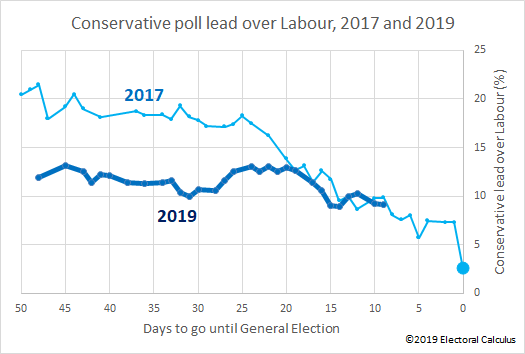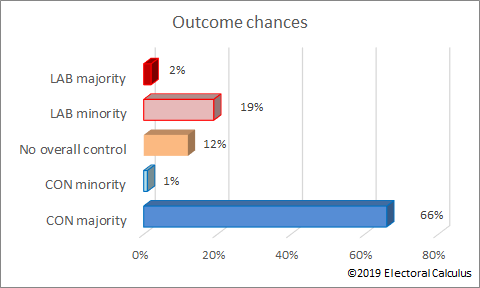The Conservatives have been losing some ground recently, but still have a clear lead over the Labour party.
| Party | 2017 Votes | 2017 Seats | Pred Votes | Low Seats | Pred Seats | High Seats |
|---|---|---|---|---|---|---|
| CON | 43.5% | 318 | 42.9% | 258 | 340 | 434 |
| LAB | 41.0% | 262 | 32.8% | 140 | 228 | 303 |
| LIB | 7.6% | 12 | 13.1% | 10 | 15 | 46 |
| Brexit | 0.0% | 0 | 3.2% | 0 | 0 | 6 |
| Green | 1.7% | 1 | 3.1% | 0 | 1 | 2 |
| SNP | 3.1% | 35 | 3.7% | 23 | 44 | 48 |
| PlaidC | 0.5% | 4 | 0.6% | 0 | 4 | 5 |
| UKIP | 1.9% | 0 | 0.0% | 0 | 0 | 0 |
| Other | 0.7% | 0 | 0.6% | 0 | 0 | 1 |
| DUP | 10 | 8 | ||||
| SF | 7 | 7 | ||||
| Alliance | 0 | 3 | ||||
| NI Other | 1 | 0 |
Prediction based on eight opinion polls from 26 Nov 2019 to 03 Dec 2019, sampling 13,123 people (Pollsters: BMG, Savanta:ComRes, Opinium, Deltapoll, Survation, Kantar, ICM Research, YouGov).
This has the Conservatives around 10pc ahead of Labour with a predicted majority of 30 seats.
The three factors which could easily change this result are Campaign Swing, Pollster Error and Tactical Voting.
The graph below shows the key statistic of the rolling average lead of the Conservatives over Labour for both this election campaign and also the 2017 campaign.

Theresa May started the campaign with an impressive lead of around 20pc. This declined gradually and then faster in the last three weeks of the campaign. The final campaign polls showed a Conservative lead of around 7pc, but the polls were not correct and the actual lead was about 2pc.
This year, the Conservatives under Boris Johnson started with a moderate lead of 12pc which held fairly steady for about a month. But in the last two weeks, the Conservative lead has appeared to droop and seems to be shadowing the 2017 trajectory in a mostly downwards direction.
With eight days of campaign to go, it remains to be seen whether history will repeat itself or whether public opinion will move in a new direction.
Another cause of uncertainty is the divergence between pollsters. We took a recent poll from each of six major pollster, all of which were conducted at the same time, and converted the percentage support figures into seats. The chart shows that the number of seats predicted by win, for each pollster's estimated vote shares.

The number of seats won ranges from 327 (which would be a majority of just 4 seats) to 386 (which would be a landslide majority of more than 100 seats). So the prediction you get depends on the pollster whom you ask.
We can also calculate the chances of the various election outcomes.

An overall Conservative majority is the most likely outcome, with a chance of around two-thirds (66pc) or odds of two-to-one on. But a Labour minority government is also quite possible, with a chance of about one in five (19pc) of odds of four-to-one against. There is also a chance of a badly hung parliament with no obvious coalition and smaller chances of a majority Labour government or a minority Conservative one.